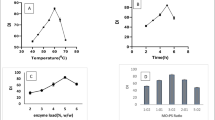Abstract
The effects of zero-trans chemically interesterified (in-es) and non-interesterified (non-in-es) cottonseed (CO), hazelnut (HO) and olive oil (OO) and their blends (25, 50 and 75%) with palm oil (PO) were studied in the production of cookies. All the experimental shortenings had zero-trans fatty acids (TFA) while the shortening contained 14.20% TFA. Incorporation of CO in PO considerably increased the linoleic acid content whereas the raising of HO and OO ratio in the blend increased the oleic acid content. Zero-TFA and lower saturated /unsaturated fatty acid ratio (SFA/UFA) of some of the experimental shortenings indicated an important in nutritional properties of cookies produced from these experimental shortenings. Cookies with in-es shortenings showed significantly higher (p < 0.05) spread ratios and L Hunter color than their non-in-es shortenings added counterparts. It can be concluded that chemical interesterification is a promising method to produce cookie shortenings with zero-TFA.

Similar content being viewed by others
References
AACC (2000) American Association of cereal chemists, approved methods of the AACC, 10th edn. The Association, St. Paul
Aini IN, Miskandar MS (2007) Utilization of palm oil and palm products in shortenings and margarines. Eur J Lipid Sci Technol 109:422–432
AOAC (1990) Official methods of analysis. Association of Official Analytical Chemists, Washington
AOCS (1989) The official methods and recommended practices of the American oil chemists’ society, 4th edn. AOCS Press, Champagin
Ascherio A, Willett WC (1997) Health effects of trans fatty acids. Am J Clin Nutr 66:1006–1010
Baldwin RR, Baldry RP, Johansen RG (1972) Fat systems for bakery products. JAOCS 49:473–477
Basturk A, Javidipour I, Boyacı IH (2007) Oxidative stability of natural and chemically interesterfied cottonseed, palm and soybean oils. J Food Lipids 14:170–188
Block CR, Harris WS, Reid KJ, Spertus JA (2008) Omega-6 and trans fatty acids in blood cell membranes: a risk factor for acute coronary syndromes? Am Hear J 156(6):1117–1123
Dhaka V, Gulia N, Ahlawat KS, Khatkar BS (2011) Trans fats – sources, health risks and alternative approach – a rewiev. J Food Sci Technol 48(5):534–541
DeMan L, DeMan J (1994) Functionality of palm oil and palm kernel oil in margarine and shortening. PORIM Occasional Papers 32:1–16
Dogan IS, Javidipour I, Akan T (2007) Effects of interesterified palm and cottonseed oil blends on cake quality. Int J Food Sci Technol 42:157–164
Jakobsen UM, Bysted A, Andersen NL, Berit L, Heitmann LB, Hartkopp HB, Leth T, Overvad K, Dyerberg J (2006) Intake of ruminant trans fatty acids and risk of coronary heart disease–an overview. Atheroscler Suppl 7(2):9–11
Javidipour I, Tuncturk Y (2007) Effect of using interesterified and non-interesterified corn and palm oil blends on quality and fatty acid composition of Turkish White cheese. Int J Food Sci Technol 42:1465–1474
Javidipour I, Vural H (2002) Effects of incorporation of interesterified plant oils on quality and fatty acid composition of Turkish-type salami. Nahrung 46:404–407
Javidipour I, Vural H, Ozbas OO, Tekin A (2005) Effects of interesterified vegetable oils and sugar beet fiber on the quality of Turkish-type salami. Int J Food Sci Technol 40:177–185
Manley D (2000) Fats and Oils. In: Technology of biscuits, crackers and cookies. 3rd edn. Woodhead Publishing Limited, Cambridge England, pp: 130–150
Micha R, Mozaffarian D (2008) Trans fatty acids: Effects on cardiometabolic health and implications for policy. Prostaglandins, leukotrienes and essential fatty acids. Lipidomics to Human Health 79(3–5):147–152
Nawar WW (1985) Lipids. In: Nawar WW (ed) Food chemistry, 2nd edn. Marcel Dekker Inc, New York, pp 139–245
Öztürk S, Özboy ÖÖ, Javidipour I, Köksel H (2008) Utilization of sugarbeet fiber and zero trans interesterified and non-interesterified shortenings in cookie production. Sugar Industry/Zuckerindustrie 133:704–709
Park DK, Terao J, Matsushita S (1983) Influence of interesterification on the antioxidative stability of vegetable oils. Agric Biol Chem 47:121–123
Petrauskaite V, Greyt WD, Kellens M, Huyghebaert A (1998) Physical and chemical properties of trans-free fats produced by chemical interesterification of vegetable oil blends. Journal American Oil Chemists Society 75:489–493
Rodriguez A, Castro E, Salinas MC, Lopez R, Miranda M (2001) Interesterification of tallow and sunflower oil. Journal American Oil Chemists Society 78:431–436
Rousseau D, Marangoni AG (1999) The effects of interesterification on physical and sensory attributes of butterfat and butterfat-canola oil spreads. Food Research International 31:381–388
Stender S, Dyerberg J, Bysted A, Leth T, Astrup A (2006) A trans world journey. Atheroscler Suppl 7:47–52
Tavella M, Peterson G, Espeche M, Cavallero E, Cipola L, Perego L, Caballero B (2000) Trans fatty acid content of a selection of foods in Argentina. Food Chemistry 69:209–213
Tsanev R, Russeva A, Rizov T, Dontcheva I (1998) Content of trans fatty acids in edible margarines. Journal American Oil Chemists Society 75:1731–1734
Vural H, Javidipour I (2002) Replacement of beef fat in frankfurters by interesterified palm, cottonseed and olive oils. European Food Research Technology 214:465–468
Vural H, Javidipour I, Ozbas OO (2004) Effects of interesterified vegetable oils and sugarbeet fiber on the quality of frankfurters. Meat Science 67:65–72
Ward J (1988) Processing canola oil products. JAOCS 65:1731–1734
WHO (1993) Fats and oils in human nutrition. Report of a joint consultation. Food and Agriculture Organization of the United Nations and the World Health Organization
Wiedermann LH (1978) Margarine and margarine oil: formulation and control. Journal American Oil Chemists Society 55:823–829
Willett WC (2006) Trans fatty acids and cardiovascular disease – epidemi-ological data. Atheroscler Suppl 7(2):5–8
Yap PH, Deman JM, Deman L (1989) Polymorphic stability of hydrogenated canola oil as affected by addition of palm oil. JAOCS 66:1784–1791
Zoulias E, Oreopoulou V, Kounalaki E (2002) Effect of fat and sugar replacement on cookie properties. Journal Science Food Agriculture 82(14):1637–1644
Acknowledgement
This study was supported by Hacettepe University Research Fund (98 02 602 003). We thank Ülker Group and Etsun Inc.
Author information
Authors and Affiliations
Corresponding author
Rights and permissions
About this article
Cite this article
Dinç, S., Javidipour, I., Özbas, Ö.Ö. et al. Utilization of zero-trans non-interesterified and interesterified shortenings in cookie production. J Food Sci Technol 51, 365–370 (2014). https://doi.org/10.1007/s13197-011-0506-x
Revised:
Accepted:
Published:
Issue Date:
DOI: https://doi.org/10.1007/s13197-011-0506-x




